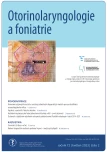Experiences with the objective examination of swallowing using the flexible endoscopy in the years 2014–2021
Authors:
M. Dubová 1; N. Lasotová 2,3; M. Budíková 4; V. Uhrová 1; N. Blažková 1
Authors‘ workplace:
Oddělení ORL, FN Brno
1; Neurologická klinika FN Brno
2; Katedra speciální a inkluzivní pedagogiky PeF MU, Brno
3; Ústav matematiky a statistiky PřF MU, Brno
4
Published in:
Otorinolaryngol Foniatr, 72, 2023, No. 2, pp. 78-86.
Category:
Original Article
doi:
https://doi.org/10.48095/ccorl202378
Overview
Introduction: Flexible endoscopic evaluation of swallowing (FEES) is an objective dia gnostic method designed to assess the oropharyngeal dysphagia. The presence of swallowing disorder and the optimal management settings signifi cantly aff ect patients’ clinical status and quality of life. Methods: From 2014 to 2021, FEES was prospectively evaluated against the penetration-aspiration scale for eight disease categories – stroke, other focal brain lesions, head and neck tumours, neurodegenerative diseases, refl ux diseases, polyneuropathy associated with artifi cial lung ventilation, cervical spine surgery and other diseases. Results: A total of 2,601 FEES examinations were carried out at our workplace. Oropharyngeal dysphagia was confi rmed in two-thirds of all cases. The highest incidence of penetration and aspiration, i.e. in more than 70% of examinations, has been shown in stroke and other focal brain lesions. In one quarter of all examinations in the total set, silent aspiration was demonstrated. Conclusion: The objective examination of swallowing FEES should be part of comprehensive hospital care for a patient at risk of dysphagia. Early detection of swallowing pathology reduces the risk of complications associated with dysphagia. FEES examination is an important dia gnostic method within the framework of interdisciplinary cooperation, not only in patients with diseases in the ENT area.
Keywords:
risk assessment – dysphagia – endoskopy – diagnostic techniques and procedures
Sources
1. Tedla M, Černý M a kol. Poruchy polykání. 2. vyd. Havlíčkův brod: Tobiáš; 2018. ISBN 978-80-7311-188-5.
2. Dubová M, Šteffl M, Lasotová N et al. Dys fagie u pacientů s nádory hlavy a krku. Onkologie 2019; 13(2): 83–86. Doi: 10.36290/ xon.2019.016.
3. Malá E, Vejražková E, Vošmik M et al. Kvalita života nemocných s rakovinou hlavy a krku ve tříletém sledování nutriční ambulancí. Otorinolaryngol Foniatr 2016; 65(1): 9–16.
4. Leonard R, Belafsky P. Dysphagia following cervical spine surgery with anterior instrumentation: evidence from fluoroscopic swallow studies. Spine (Phila Pa 1976) 2011; 36(25): 2217–2223. Doi:10.1097/ BRS.0b013e318205a1 a7.
5. Daniels SK, Foundas AL, Iglesia GC et al. Lesion site in unilateral stroke patients with dysphagia. J Stroke Cerebrovasc Dis 1996; 6(1): 30–34. Doi:10.1016/ s1052-3057(96)80023-1.
6. Huang KL, Liu TY, Huang YC et al. Functional outcome in acute stroke patients with oropharyngeal dysphagia after swallowing therapy. J Stroke Cerebrovasc Dis. 2014; 23(10): 2547–2553. Doi: 10.1016/ j.jstrokecere brovasdis. 2014.05.031.
7. Hunter KU, Lee OE, Lyden TH et al. Aspiration pneumonia after chemo-intensity-modulated radiation therapy of oropharyngeal carcinoma and its clinical and dysphagia-related predictors. Head Neck 2014; 36(1): 120–125. Doi: 10.1002/ hed.23275.
8. Riff at F, Gunaratne DA, Palme CE. Swallowing assessment and management pre and post head and neck cancer treatment. Curr Opin Otolaryngol Head Neck Surg 2015; 23(6): 440–447. Doi:10.1097/ MOO.0000000000000205.
9. Warnecke T, Teismann I, Oelenberg S et al. The safety of fi beroptic endoscopic evaluation of swallowing in acute stroke patients. Stroke 2009; 40(2): 482–486. Doi: 10.1161/ STROKEAHA. 108.520775.
10. Newman R, Vilardell N, Clavé P et al. Eff ect of bolus viscosity on the safety and effi cacy of swallowing and the kinematics of the swallow response in patiens with oropharyngeal dysphagia: white paper by the Europian society for swallowing disorders (ESSD). Dysphagia 2016; 31: 232–249. Doi: 10.1007/ s00455-016-9696-8.
11. Hedström J, Tuomi L, Finizia C et al. Correlations Between Patient-Reported Dysphagia Screening and Penetration – Aspiration Scores in Head and Neck Cancer Patients Post-oncological Treatment. Dysphagia. 2018; 33: 206–215. Doi:10.1007/ s00455-017-9847-6.
12. Ihalainen T, Rinta-Kiikka I, Luoto TM et al. Risk factors for laryngeal penetration-aspiration in patients with acute traumatic cervical spinal cord injury. Spine J 2018; 18(1): 81–87. Doi: 10.1016/ j.spinee.2017.06.033.
13. Langmore SE, Krisciunas GP, Warner H et al. Abnormalities of Aspiration and Swallowing Function in Survivors of Acute Respiratory Failure. Dysphagia 2021; 36: 831–841. Doi: 10.1007/ s00455-020-10199-8.
14. Kim YH, Han TR, Nam HS et al. Temporal characteristics of laryngeal penetration and aspiration in stroke patients. NeuroRehabilitation 2019; 44(2): 231–238. Doi:10.3233/ NRE-182569. 15. Rosenbek JC, Robbins JA, Roecker EB et al. A penetration-aspiration scale. Dysphagia 1996; 11(2): 93–98. Doi: 10.1007/ BF00417897.
Labels
Audiology Paediatric ENT ENT (Otorhinolaryngology)Article was published in
Otorhinolaryngology and Phoniatrics

2023 Issue 2
Most read in this issue
- Cochlear implantation as a solution for unilateral deafness in children – first experience
- Experiences with the objective examination of swallowing using the flexible endoscopy in the years 2014–2021
- Hearing loss in patients with Fabry disease
- Modern therapeutic options for Frey syndrome – analysis of five cases
